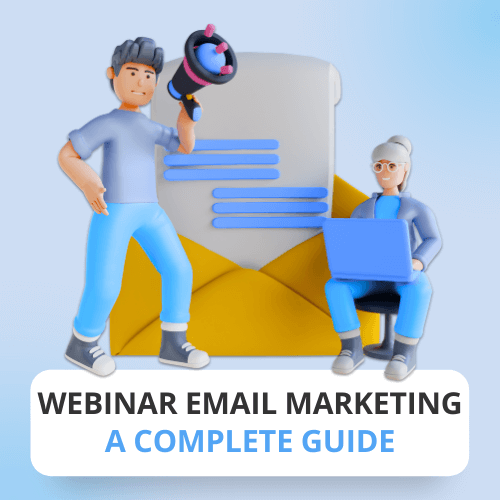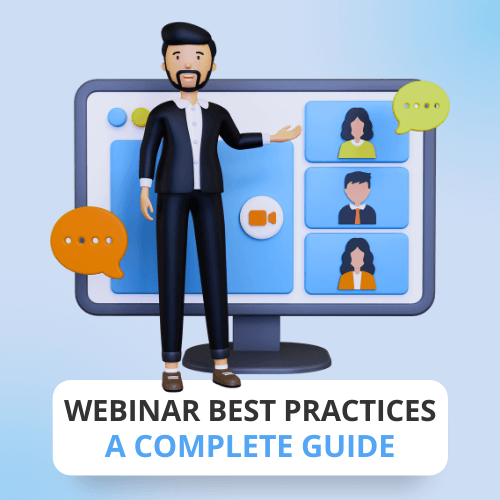6 Best Practices To Create a Webinar Landing Page That Converts
You might have the best webinar in the world but if nobody joins in, it doesn’t matter. So, you need to get the word out there, and it’s your landing page that gives potential attendees their first impression of you. Imagine that your webinar is like a party – you may have beautiful invitations that no one could possibly turn down, but if people arrive at your doorstep and see a spooky-looking haunted house (or an uninviting landing page), they’ll probably think twice about coming in. That’s why following the best practices for landing pages is so important. It’s when people decide to either knock on your door or walk away. So, how do you create high converting landing pages?
Start with a great title
Only 20% of landing page visitors will read anything past the title. So, it’s crucial that you start with a bang. You not only want to catch the reader’s attention, but also hook them into reading the remaining content. One of the easiest ways to do this is by using a great title. You can highlight the problem you’re trying to solve, include numbers in your headline, or ask a question that resonates with your attendees’ problems, such as ‘How to Create a Webinar Landing Page That Converts’.
Keep it simple, but informative
It’s important that your landing page isn’t overflowing with information – you should save that for the webinar. Still, you need to provide vital details, such as the date, time, duration, speakers, and a small introduction. A good way to organize your information without cluttering the page is by adding subheaders. On top of the self-explanatory ones that allow the reader to check the information they want right away, you can also add subheaders to break up your copy and make it more readable.
Write compelling copy
Writing the copy for a landing page is similar to writing a blog, meaning that you need to follow copywriting best practices. Most people will read this information before signing up for a webinar, so you must catch their interest. You also need to make sure your copy is error-free, easy to read, and informative. You don’t want it to come off as a sales pitch but highlight your webinar’s unique selling points – why is it worth your attendee’s time? If you’ve already hosted webinars before, it’s also worthwhile to include testimonials from past viewers.
Finish with a strong call-to-action
30% discount on annual GoToWebinar subscriptions
You can save money on your GoToWebinar subscription by choosing to pay annually instead of monthly, getting up to 30% off your subscription plan.
Save 30% on GoToWebinar
Calls-to-action are critical to convert online page visitors into webinar attendees. So, make sure that visitors easily know how to sign up for the webinar, as this is the main objective of your landing page. In other words, create a CTA button that is large enough to be noticed and use a contrasting color. The call-to-action also needs to be compelling – a button saying ‘Subscribe’ is fine, but it can be a little dull. Instead, get creative and write something ‘Start Saving Money’ or ‘Buckle Up and Let’s Go!’.
Include visuals
There’s a reason why YouTube took the internet by storm – people find video entertaining, engaging, and easier to digest. Consequently, adding visuals to your webinar landing page is worthwhile. For example, you can ask the webinar speakers to record an introduction or even share your latest webinar highlights.
Unfortunately, creating video content is time consuming. Not only do you need to invest time recording the video, but you also have to edit, export, and upload it. That’s why many people include images instead. We’re not saying to just use stock pictures, though. While these can be perfect for enhancing your landing page, they are usually far too generic. Instead, consider designing an infographic with important information for your target audience. For example, if you’re running a webinar that solves a specific problem, you can have an infographic with statistics that showcase why your solution is going to work.
Reward webinar attendees with free stuff
Everyone loves free stuff, and this is a great way to make people subscribe and attend your webinar. Of course, this should be saved as a reward. You shouldn’t offer a free ebook right off the bat, as many people will subscribe just to get the ebook and then won’t show up on webinar day. Instead, inform landing page visitors that they’ll get a free ebook with tips and tricks to solve their problem at the end of the session.

Optimize through A/B testing
Finally, test similar versions of the same landing page to understand which one converts better. Optimization takes time, as there’s always something that you can improve. By allowing you to understand which landing page is performing better, A/B testing helps you to come up with optimized pages that provide the highest conversion rate possible.
Webinars are a great way to promote services and increase customer loyalty. By following these best practices and creating high converting landing pages, you’ll increase your number of webinar attendees in no time.
Best webinar software of 2025
Host pre-recorded webinars
Excellent customer service

 Daniel C.
Daniel C.
 Inês P.
Inês P.






User feedback